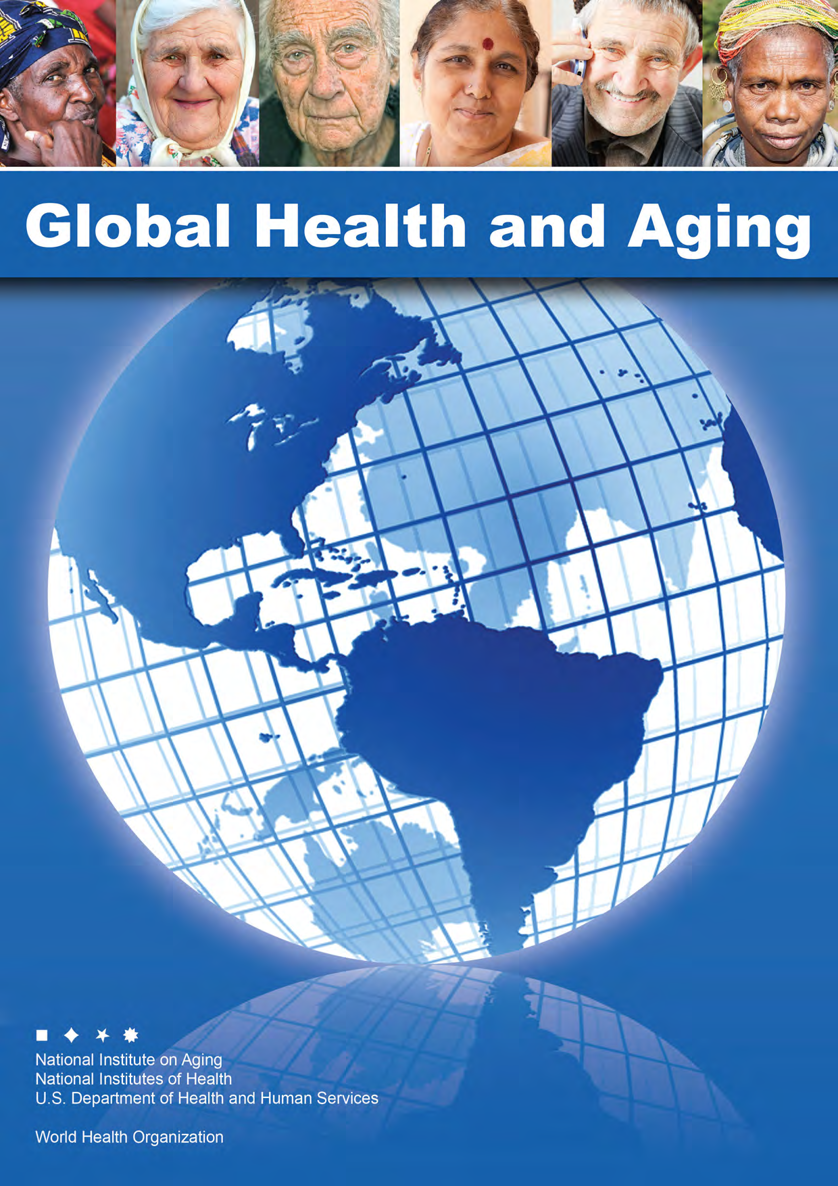
2
Global Health and Aging
Photo credits front cover, left to right (Dreamstime.com): Djembe; Sergey Galushko; Laurin Rinder; Indianeye; Magomed Magomedagaev; and Antonella865.

Contents
Preface 1
Overview
2
Humanity’s Aging 4
Living Longer 6
New Disease Patterns 9
Longer Lives and Disability 12
New Data on Aging and Health 16
Assessing the Cost of Aging and Health Care 18
Health and Work 20
Changing Role of the Family 22
Suggested Resources 25
4
Global Health and Aging



Preface
The world is facing a situation without precedent: We soon will have more older people than children and more people at extreme old age than ever before. As both the proportion of older people and the length of life increase throughout the world, key questions arise. Will population aging be accompanied by a longer period of good health, a sustained sense of well-being, and extended periods of social engagement and productivity, or will it be associated with more illness, disability, and dependency? How will aging affect health care and social costs? Are these futures inevitable, or can we act to establish a physical and social infrastructure that might foster better health and wellbeing in older age? How will population aging play out differently for low-income countries that will age faster than their counterparts have, but before they become industrialized and wealthy?
This brief report attempts to address some of these questions. Above all, it emphasizes the central role that health will play moving forward. A better understanding of the changing relationship between health with age is crucial if we are to create a future that takes full advantage of the powerful resource inherent in older populations. To do so, nations must develop appropriate data systems and research capacity to monitor and understand these patterns and relationships, specifically longitudinal studies that incorporate measures of health, economic status, family, and well-being. And research needs to be better coordinated if we are to discover the most cost-effective ways to maintain healthful life styles and everyday functioning in countries at different stages of economic development and with varying resources. Global efforts are required to understand and find cures or ways to prevent such age-related diseases as Alzheimer’s and frailty and to implement existing knowledge about the prevention and treatment of heart disease, stroke, diabetes, and cancer.
Managing population aging also requires building needed infrastructure and institutions as soon as possible. The longer we delay, the more costly and less effective the solutions are likely to be.
Population aging is a powerful and transforming demographic force. We are only just beginning to comprehend its impacts at the national and global levels. As we prepare for a new demographic reality, we hope this report raises awareness not only about the critical link between global health and aging, but also about the importance of rigorous and coordinated research to close gaps in our knowledge and the need for action based on evidence-based policies.
Richard
Suzman,
PhD
John Beard, MBBS, PhD
Director, Division of Behavioral and Social Research Dir ector, Department of Ageing and Life Course
National Institute on Aging
World Health Organization
National Institutes of Health
Preface
5
1

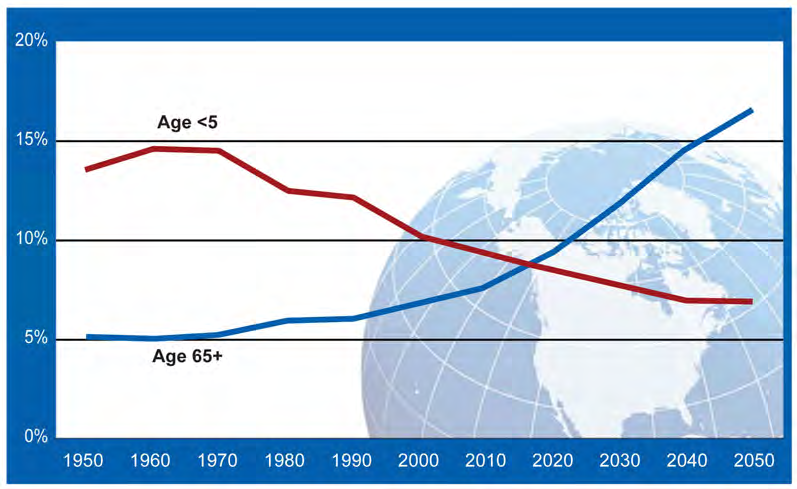
Overview
The world is on the brink of a demographic
the major health threats were infectious and
milestone. Since the beginning of recorded
parasitic diseases that most often claimed
history, young children have outnumbered
the lives of infants and children. Currently,
their elders. In about five years’ time, however,
noncommunicable diseases that more commonly
the number of people aged 65 or older will
affect adults and older people impose the
outnumber children under age 5. Driven by
greatest burden on global health.
falling fertility rates and remarkable increases in
life expectancy, population aging will continue,
In today’s developing countries, the rise of
even accelerate (Figure 1). The number of
chronic noncommunicable diseases such as
people aged 65 or older is projected to grow
heart disease, cancer, and diabetes reflects
from an estimated 524 million in 2010 to nearly
changes in lifestyle and diet, as well as aging.
1.5 billion in 2050, with most of the increase in
The potential economic and societal costs of
developing countries.
noncommunicable diseases of this type rise
sharply with age and have the ability to affect
The remarkable improvements in life
economic growth. A World Health Organization
expectancy over the past century were part
analysis in 23 low- and middle-income countries
of a shift in the leading causes of disease
estimated the economic losses from three
and death. At the dawn of the 20th century,
noncommunicable diseases (heart disease,
Figure 1.
Young Children and Older People as a Percentage of Global Population: 1950-2050
Source: United Nations. World Population Prospects: The 2010 Revision.
Available at: http://esa.un.org/unpd/wpp.
2
Global Health and Aging

stroke, and diabetes) in these countries would
With continuing declines in death rates among
total US$83 billion between 2006 and 2015.
older people, the proportion aged 80 or older
is rising quickly, and more people are living
Reducing severe disability from disease
past 100. The limits to life expectancy and
and health conditions is one key to holding
lifespan are not as obvious as once thought.
down health and social costs. The health
And there is mounting evidence from cross-
and economic burden of disability also can
national data that—with appropriate policies
be reinforced or alleviated by environmental
and programs—people can remain healthy
characteristics that can determine whether
and independent well into old age and can
an older person can remain independent
continue to contribute to their communities
despite physical limitations. The longer people
and families.
can remain mobile and care for themselves,
the lower are the costs for long-term care to
The potential for an active, healthy old age
families and society.
is tempered by one of the most daunting and
potentially costly consequences of ever-longer
Because many adult and older-age health
life expectancies: the increase in people with
problems were rooted in early life experiences
dementia, especially Alzheimer’s disease. Most
and living conditions, ensuring good child
dementia patients eventually need constant
health can yield benefits for older people.
care and help with the most basic activities
In the meantime, generations of children
of daily living, creating a heavy economic and
and young adults who grew up in poverty
social burden. Prevalence of dementia rises
and ill health in developing countries will be
sharply with age. An estimated 25-30 percent
entering old age in coming decades, potentially
of people aged 85 or older have dementia.
increasing the health burden of older
Unless new and more effective interventions
populations in those countries.
are found to treat or prevent Alzheimer’s
disease, prevalence is expected to rise
dramatically with the aging of the population
in the United States and worldwide.
Aging is taking place alongside other broad
social trends that will affect the lives of older
people. Economies are globalizing, people are
more likely to live in cities, and technology
is evolving rapidly. Demographic and family
changes mean there will be fewer older people
with families to care for them. People today
have fewer children, are less likely to be
married, and are less likely to live with older
generations. With declining support from
families, society will need better information
and tools to ensure the well-being of the
world’s growing number of older citizens.
Dundanim | Dreamstime.com
Overview
3

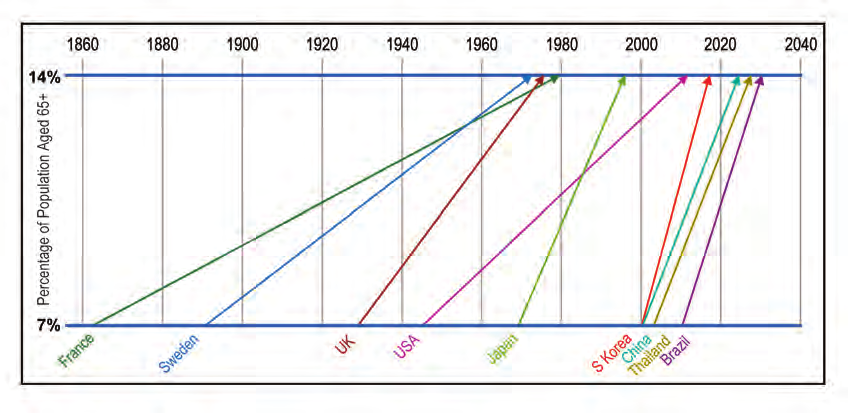
Humanity’s Aging
In 2010, an estimated 524 million people were
nearly three children per woman around 1950.
aged 65 or older—8 percent of the world’s
Even more crucial for population aging, fertility
population. By 2050, this number is expected to fell with surprising speed in many less developed nearly triple to about 1.5 billion, representing
countries from an average of six children in
16 percent of the world’s population. Although
1950 to an average of two or three children
more developed countries have the oldest
in 2005. In 2006, fertility was at or below the
population profiles, the vast majority of
two-child replacement level in 44 less developed
older people—and the most rapidly aging
countries.
populations—are in less developed countries.
Between 2010 and 2050, the number of older
Most developed nations have had decades to
people in less developed countries is projected to adjust to their changing age structures. It took increase more than 250 percent, compared with
more than 100 years for the share of France’s
a 71 percent increase in developed countries.
population aged 65 or older to rise from 7
percent to 14 percent. In contrast, many less
This remarkable phenomenon is being driven
developed countries are experiencing a rapid
by declines in fertility and improvements in
increase in the number and percentage of older
longevity. With fewer children entering the
people, often within a single generation (Figure
population and people living longer, older
2). For example, the same demographic aging
people are making up an increasing share of the
that unfolded over more than a century in
total population. In more developed countries,
France will occur in just two decades in Brazil.
fertility fell below the replacement rate of two
Developing countries will need to adapt quickly
live births per woman by the 1970s, down from
to this new reality. Many less developed nations
Figure 2.
The Speed of Population Aging
Time required or expected for percentage of population aged 65 and over to rise from 7 percent to 14 percent
Source: Kinsella K, He W. An Aging World: 2008. Washington, DC: National Institute on Aging and U.S. Census Bureau, 2009.
4
Global Health and Aging
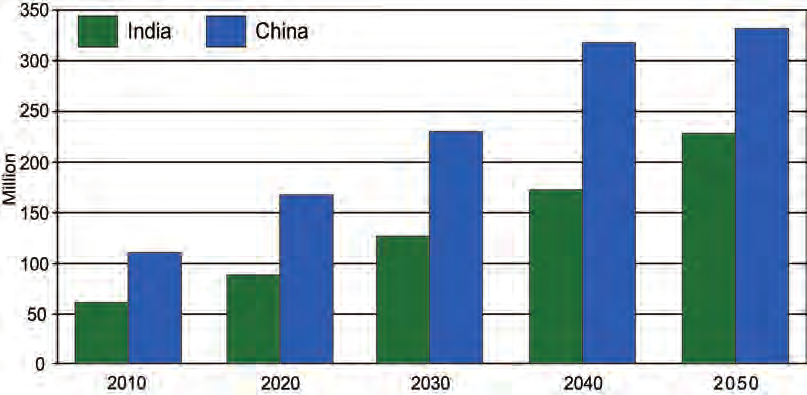

will need new policies that ensure the financial
security of older people, and that provide the
health and social care they need, without the
same extended period of economic growth
experienced by aging societies in the West.
In other words, some countries may grow old
before they grow rich.
In some countries, the sheer number of
people entering older ages will challenge
national infrastructures, particularly health
systems. This numeric surge in older people is
dramatically illustrated in the world’s two most
populous countries: China and India (Figure 3).
China’s older population – those over age 65 –
will likely swell to 330 million by 2050 from 110
million today. India’s current older population
of 60 million is projected to exceed 227 million
in 2050, an increase of nearly 280 percent from
today. By the middle of this century, there
could be 100 million Chinese over the age of 80.
This is an amazing achievement considering
that there were fewer than 14 million people
this age on the entire planet just a century ago.
Crystal Craig | Dreamstime.com
Figure 3.
Growth of the Population Aged 65 and Older in India and China: 2010-2050
Source: United Nations. World Population Prospects: The 2010 Revision.
Available at: http://esa.un.org/unpd/wpp.
Humanity’s Aging
5


Living Longer
The dramatic increase in average life expectancy pathways. This transition encompasses a during the 20th century ranks as one of
broad set of changes that include a decline
society’s greatest achievements. Although most
from high to low fertility; a steady increase
babies born in 1900 did not live past age 50, life
in life expectancy at birth and at older ages;
expectancy at birth now exceeds 83 years in
and a shift in the leading causes of death and
Japan—the current leader—and is at least 81
illness from infectious and parasitic diseases
years in several other countries. Less developed
to noncommunicable diseases and chronic
regions of the world have experienced a steady
conditions. In early nonindustrial societies, the
increase in life expectancy since World War
risk of death was high at every age, and only a
II, although not all regions have shared in
small proportion of people reached old age. In
these improvements. (One notable exception
modern societies, most people live past middle
is the fall in life expectancy in many parts of
age, and deaths are highly concentrated at older
Africa because of deaths caused by the HIV/
ages.
AIDS epidemic.) The most dramatic and rapid
gains have occurred in East Asia, where life
The victories against infectious and parasitic
expectancy at birth increased from less than 45
diseases are a triumph for public health
years in 1950 to more than 74 years today.
projects of the 20th century, which immunized
millions of people against smallpox, polio,
These improvements are part of a major
and major childhood killers like measles. Even
transition in human health spreading around
earlier, better living standards, especially
the globe at different rates and along different
more nutritious diets and cleaner drinking
water, began to reduce serious infections and
prevent deaths among children. More children
were surviving their vulnerable early years
and reaching adulthood. In fact, more than
60 percent of the improvement in female life
expectancy at birth in developed countries
between 1850 and 1900 occurred because more
children were living to age 15, not because more
adults were reaching old age. It wasn’t until
the 20th century that mortality rates began
to decline within the older ages. Research for
more recent periods shows a surprising and
continuing improvement in life expectancy
among those aged 80 or above.
The progressive increase in survival in these
oldest age groups was not anticipated by
demographers, and it raises questions about how
high the average life expectancy can realistically
rise and about the potential length of the human
lifespan. While some experts assume that life
Berna Namoglu | Dreamstime.com
expectancy must be approaching an upper limit,
6
Global Health and Aging
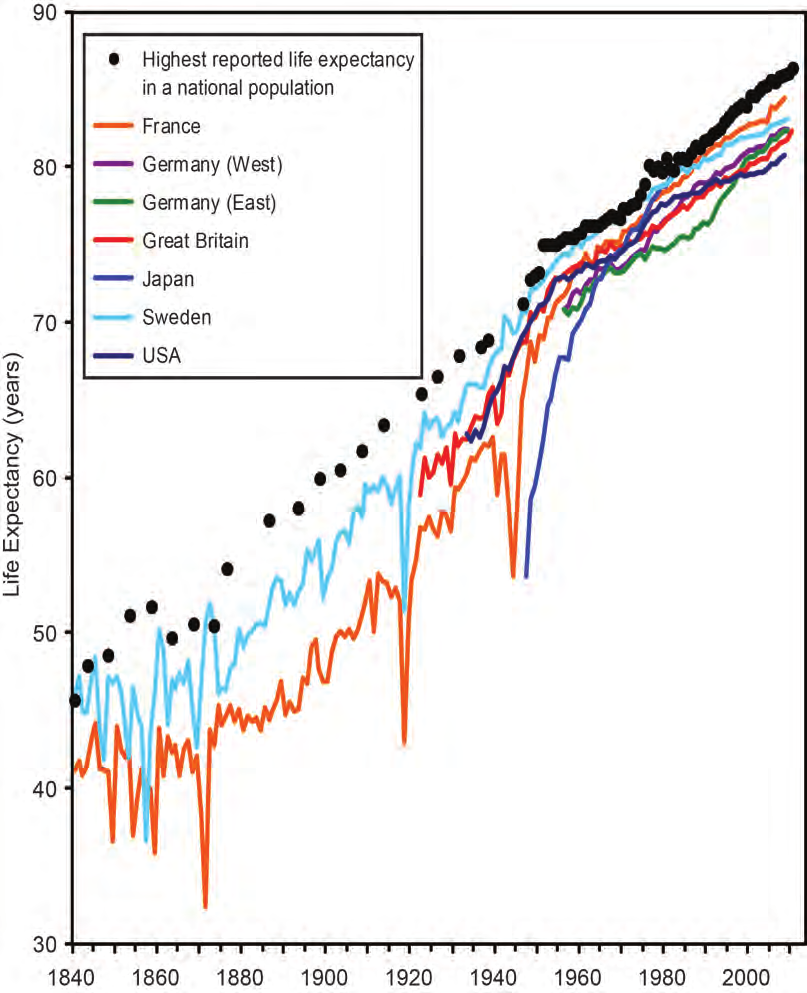
Figure 4.
Female Life Expectancy in Developed Countries: 1840-2009
Source: Highest reported life expectancy for the years 1840 to 2000 from online supplementary material to Oeppen J, Vaupel JW. Broken limits to life expectancy. Science 2002; 296:1029-1031. All other data points from the Human Mortality Database (http://www.mortality.org) provided by Roland Rau (University of Rostock). Additional discussion can be found in Christensen K, Doblhammer G, Rau R, Vaupel JW. Aging populations: The challenges ahead.
The Lancet 2009; 374/9696:1196-1208.
Living Longer
7

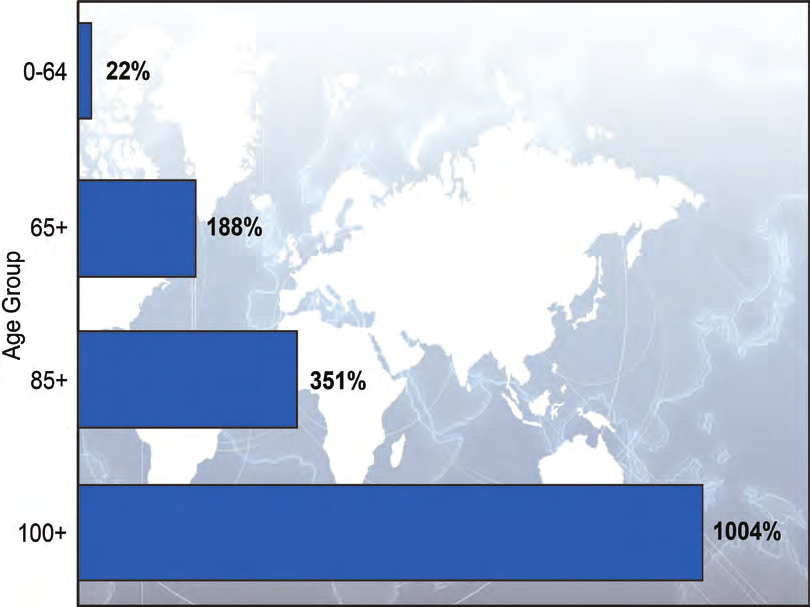
data on life expectancies between 1840 and 2007
global level, the 85-and-over population is
show a steady increase averaging about three
projected to increase 351 percent between 2010
months of life per year. The country with the
and 2050, compared to a 188 percent increase for
highest average life expectancy has varied over
the population aged 65 or older and a 22 percent
time (Figure 4). In 1840 it was Sweden and
increase for the population under age 65 (Figure 5).
today it is Japan—but the pattern is strikingly
similar. So far there is little evidence that life
The global number of centenarians is projected
expectancy has stopped rising even in Japan.
to increase 10-fold between 2010 and 2050. In
the mid-1990s, some researchers estimated that,
The rising life expectancy within the older
over the course of human history, the odds of
population itself is increasing the number and
living from birth to age 100 may have risen from
proportion of people at very old ages. The
1 in 20,000,000 to 1 in 50 for females in low-
“oldest old” (people aged 85 or older) constitute
mortality nations such as Japan and Sweden.
8 percent of the world’s 65-and-over population: This group’s longevity may increase even faster 12 percent in more developed countries and 6
than current projections assume—previous
percent in less developed countries. In many
population projections often underestimated
countries, the oldest old are now the fastest
decreases in mortality rates among the oldest
growing part of the total population. On a
old.
Figure 5.
Percentage Change in the World’s Population by Age: 2010-2050
Source: United Nations, World Population Prospects: The 2010 Revision.
Available at: http://esa.un.org/unpd/wpp.
8
Global Health and Aging

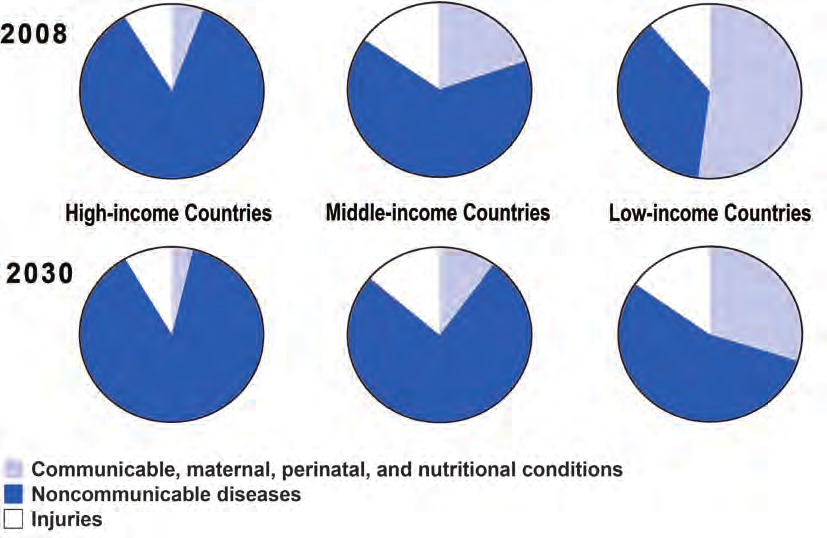
New Disease Patterns
The transition from high to low mortality
major epidemiologic trends of the current
and fertility that accompanied socioeconomic
century is the rise of chronic and degenerative
development has also meant a shift in
diseases in countries throughout the world—
the leading causes of disease and death.
regardless of income level.
Demographers and epidemiologists describe this
shift as part of an “epidemiologic transition”
Evidence from the multicountry Global Burden
characterized by the waning of infectious and
of Disease project and other international
acute diseases and the emerging importance of
epidemiologic research shows that health
chronic and degenerative diseases. High death
problems associated with wealthy and aged
rates from infectious diseases are commonly
populations affect a wide and expanding
associated with the poverty, poor diets, and
swath of world population. Over the next
limited infrastructure found in developing
10 to 15 years, people in every world region
countries. Although many developing countries
will suffer more death and disability from
still experience high child mortality from
such noncommunicable diseases as heart
infectious and parasitic diseases, one of the
disease, cancer, and diabetes than from
Figure 6.
The Increasing Burden of Chronic Noncommunicable Diseases: 2008 and 2030
Source: World Health Organization, Projections of Mortality and Burden of Disease, 2004-2030.
Available at: http://www.who.int/healthinfo/global_burden_disease/projections/en/index.html.
New Disease Patterns
9
infectious and parasitic diseases. The myth
Lasting Importance of Childhood Health
that noncommunicable diseases affect mainly
affluent and aged populations was dispelled by
A growing body of research finds that many
the project, which combines information about
health problems in adulthood and old age stem
mortality and morbidity from every world region






















